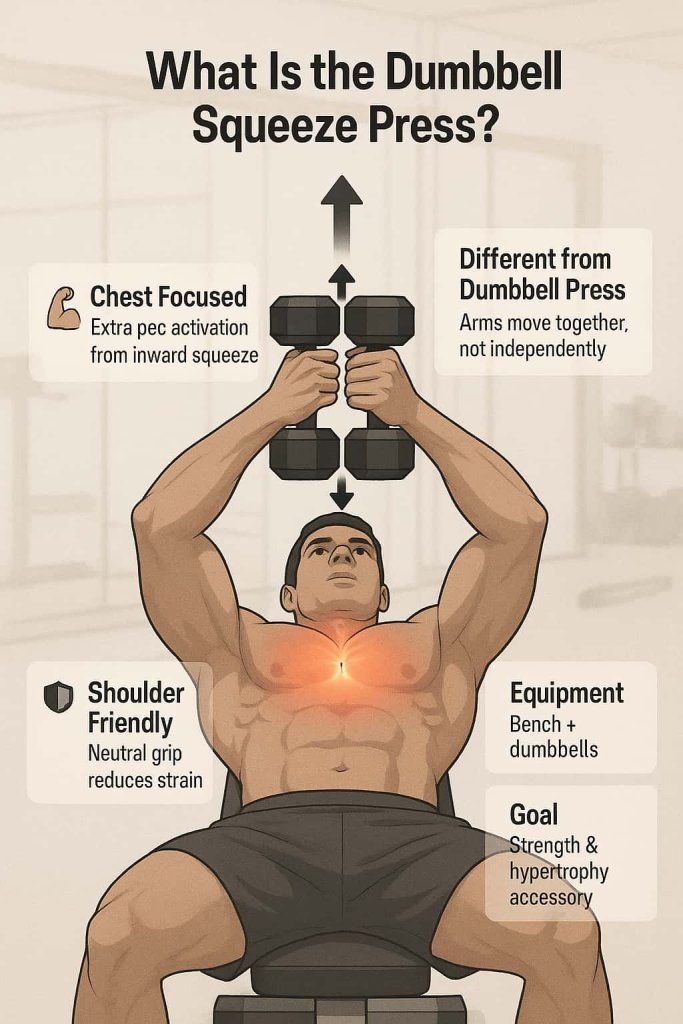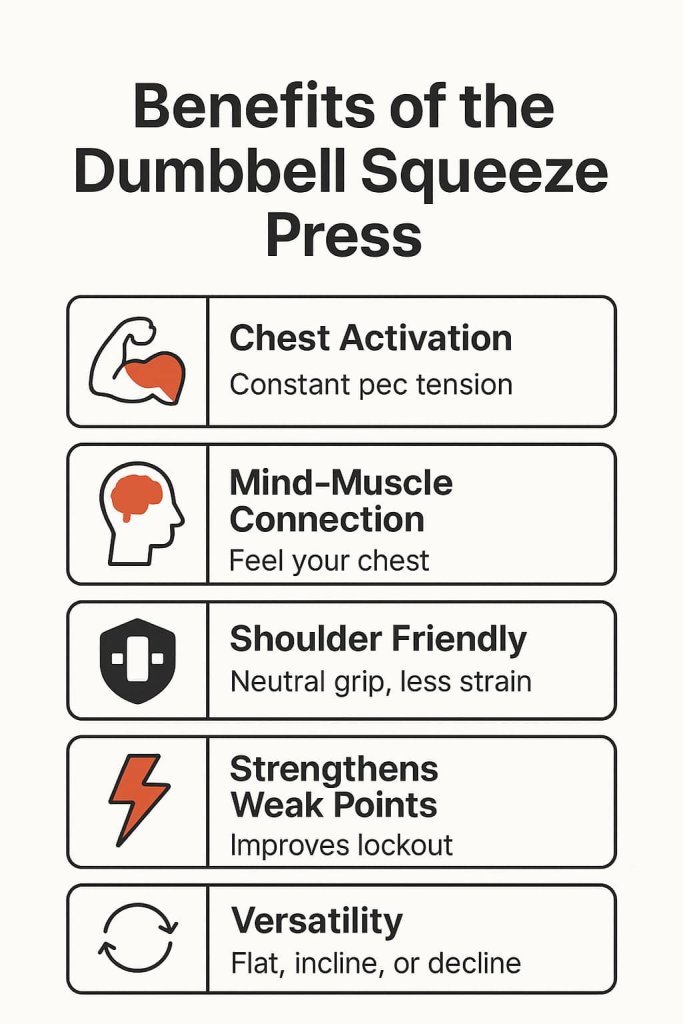The dumbbell squeeze press is one of the best chest-building exercises most lifters overlook. It combines the pressing power of a bench press with the inward squeeze of a flye, creating constant chest tension and powerful muscle activation.

This exercise is important because it recruits your chest, triceps, and shoulders in one movement while enhancing the mind-muscle connection. Whether your goal is strength, hypertrophy, or shoulder-friendly pressing, the squeeze press is a must-add.
In this guide, you’ll learn exactly how to do the dumbbell squeeze press, the muscles it works, its benefits, variations, programming tips, and common mistakes to avoid.
What Is the Dumbbell Squeeze Press?
The dumbbell squeeze press (also called the hex press or champagne press) is a chest exercise performed with two dumbbells pressed together throughout the movement.

Unlike a traditional dumbbell bench press where arms move independently, here you actively push the dumbbells inward while pressing upward, creating extra chest activation.
- Equipment needed: Flat, incline, or decline bench + dumbbells
- Difficulty: Beginner to intermediate
- Type: Strength & hypertrophy accessory
How to Do the Dumbbell Squeeze Press (Step-by-Step)
- Setup
- Lie on a flat bench with two dumbbells resting on your thighs.
- Kick the dumbbells up and bring them together above your chest.
- Grip them with a neutral grip (palms facing each other).
- Execution
- Squeeze the dumbbells together as hard as possible.
- Slowly lower them toward your chest while maintaining pressure.
- Press the dumbbells back up in a controlled motion, never letting them drift apart.
- Form Tips
- Keep your elbows tucked at about 45°.
- Avoid flaring shoulders — chest should drive the lift.
- Move in a slow, controlled tempo (2–3 seconds down).
- Maintain the squeeze at the bottom and top of each rep.
Muscles Worked by the Dumbbell Squeeze Press
- Primary: Pectoralis major (inner and mid-chest)
- Secondary:
- Anterior deltoids (front shoulders)
- Triceps brachii
- Stabilizers: rotator cuff, core, and upper back
👉Research shows that chest exercises emphasizing horizontal adduction — the same action used in the dumbbell squeeze press — lead to higher pectoralis activation compared to standard presses (Chaves et al., 2020; Muyor et al., 2023).
Benefits of the Dumbbell Squeeze Press

- Superior Chest Activation: Continuous squeeze creates constant pec tension.
- Improved Mind-Muscle Connection: Great for “feeling” your chest working.
- Shoulder Friendly: Neutral grip reduces shoulder strain compared to barbell presses.
- Strengthens Weak Points: Helps with lockout and sticking points in bench press.
- Versatility: Works on flat, incline, or decline benches.
Variations of the Dumbbell Squeeze Press
1. Incline Dumbbell Squeeze Press
Why it works:
The incline angle (30–45°) shifts the focus from the mid-chest to the upper pectorals (clavicular head). This helps build a fuller, higher chest while still engaging shoulders and triceps.
How to do it:
- Set an adjustable bench to 30–45° incline.
- Hold dumbbells above your chest, pressed together (palms facing each other).
- Lower them slowly to the upper chest while maintaining inward pressure.
- Press back up, squeezing dumbbells together the whole time.
Muscles worked: Upper chest, triceps, anterior delts.
Trainer Tip: Avoid setting the bench too high (above 45°), which shifts tension onto shoulders instead of chest.
2. Decline Dumbbell Squeeze Press
Why it works:
The decline angle targets the lower pectorals (sternal head). This move enhances lower chest thickness and can create a more defined, “shelf-like” appearance.
How to do it:
- Set a decline bench (15–30°).
- Grip dumbbells together above the lower chest.
- Lower with control until dumbbells reach chest level.
- Press back up, maintaining constant squeeze.
Muscles worked: Lower chest, triceps, anterior delts.
Trainer Tip: Keep your back and shoulders firmly on the bench—don’t arch excessively, which can reduce chest activation.
3. Reverse-Grip Squeeze Press
Why it works:
Using a supinated grip (palms facing you) puts more emphasis on the upper chest fibers and recruits the triceps more strongly. It’s also shoulder-friendly for some lifters with pressing discomfort.
How to do it:
- Lie on a flat bench holding dumbbells with palms facing you.
- Press the dumbbells together above your chest.
- Lower under control, elbows tucked slightly closer to your sides.
- Push back up while squeezing dumbbells together.
Muscles worked: Upper chest, triceps, anterior delts.
Trainer Tip: Start lighter than usual—reverse grip can feel awkward until you get used to the movement.
4. Tempo Squeeze Press
Why it works:
Slowing the eccentric phase (lowering) creates eccentric overload, which boosts muscle hypertrophy and increases time under tension.
How to do it:
- Perform a standard dumbbell squeeze press on a flat bench.
- Lower the dumbbells for 3–5 seconds while keeping them pressed together.
- Pause briefly at the bottom, then press up explosively.
- Repeat for 8–12 reps.
Muscles worked: Full chest, triceps, shoulders (with extra tension on chest due to extended time under load).
Trainer Tip: Use moderate weight—you don’t need heavy dumbbells since slow eccentrics multiply the intensity.
How to Program the Dumbbell Squeeze Press
- For Hypertrophy (Muscle Growth):
- 3–4 sets of 10–15 reps
- Light to moderate weight, focus on constant tension
- For Strength / Activation:
- 2–3 sets of 8–12 reps
- Use as a warm-up or accessory before barbell bench press
- Frequency:
- 1–2 times per week as part of your chest or push day routine
| Goal | Sets/Reps | Rest | Notes |
|---|---|---|---|
| Muscle Growth | 3–4 × 10–15 | 60–90 sec | Focus on squeeze |
| Strength | 2–3 × 8–12 | 90 sec | Use moderate weight |
| Activation | 2 × 12–15 | 45–60 sec | Warm-up before pressing |
Common Mistakes to Avoid
- ❌ Letting dumbbells drift apart — reduces chest activation
- ❌ Using too much weight — form breaks down, shoulders take over
- ❌ Flaring elbows wide — risks shoulder strain
- ❌ Rushing reps — time under tension is key
Dumbbell Squeeze Press vs. Bench Press
| Feature | Dumbbell Squeeze Press | Traditional Bench Press |
|---|---|---|
| Chest Activation | High (constant tension) | High but less adduction |
| Weight Load | Lighter | Heavier |
| Shoulder Stress | Lower | Higher |
| Goal | Hypertrophy, chest feel | Strength, heavy load |
FAQs About the Dumbbell Squeeze Press
1. Is the dumbbell squeeze press good for beginners?
Yes, beginners can use light dumbbells to learn chest activation safely.
2. Can I lift heavy with the squeeze press?
Not ideal. Focus on lighter to moderate weights since squeezing limits load.
3. Should I replace bench press with this exercise?
No — use it as an accessory to complement bench press, not replace it.
4. What bench angle is best?
Flat for overall chest, incline for upper pecs, decline for lower pecs.
5. How often should I do it?
1–2 times per week, depending on your total chest training volume.
6. Do I need hex dumbbells?
No, round dumbbells work too — as long as you maintain squeeze.
7. Is this safe for shoulders?
Yes, the neutral grip reduces shoulder strain, but use good form and moderate weight.
Conclusion
The dumbbell squeeze press is the chest builder most lifters are missing. It creates unmatched pec activation, strengthens weak points, and protects your shoulders compared to heavy barbell pressing.
👉 Add 2–3 sets of squeeze presses to your next chest workout, and you’ll quickly feel the difference in inner-chest growth and control.
